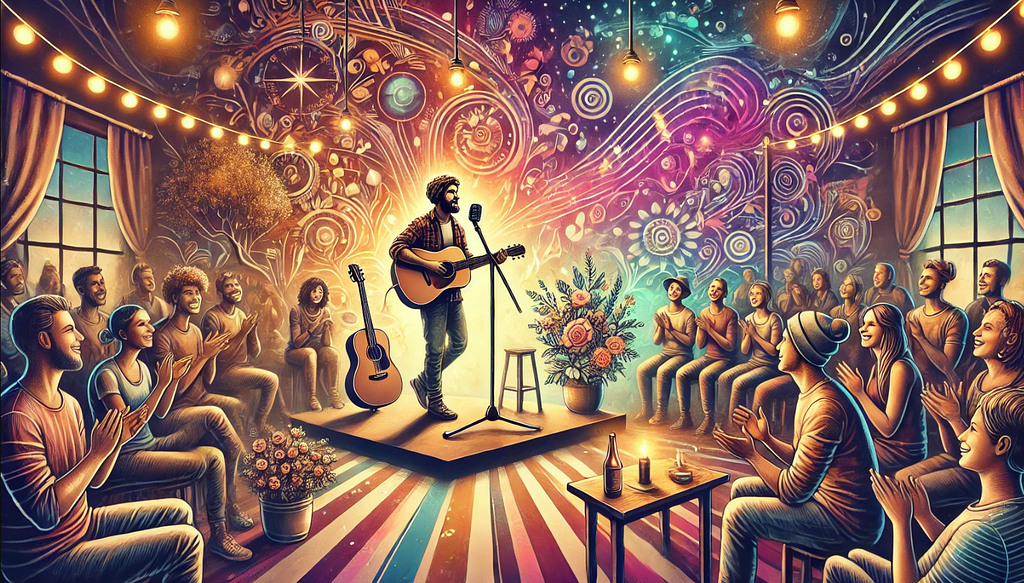Here’s an excerpt from my upcoming book, Soulforce Arts: The Vital New Role for Musicians & Artists in a World That’s Lost Its Mind.
This excerpt is the opening of my chapter on wellness for musicians and artists. Let me know what you think!
Also, I’m currently running a Kickstarter campaign to help pay for self-publishing costs. Please consider donating on or spreading the word to artists and musicians who want to make world-changing art, and who are concerned about climate change and other social ills.
Cheers,
Joseph
Can a Happy Artist Be a Great Artist?
“It is no measure of health to be well-adjusted to a profoundly sick society.”
— Jiddu Krishnamurti
“Life is truly known only to those who suffer, lose, endure adversity and stumble from defeat to defeat.”
— Anais Nin, Author
“Let us build a happy little cloud which floats around the sky!”
— Bob Ross, Painter
There is a common debate about the kinds of life circumstances that produce great art: can happy, well-adjusted people create great art, or is it only those who have had the most difficult lives?
In the Story of the Struggling Artist, difficult life circumstances are seen as beneficial to the creative process because they often call upon our innermost reserves of resourcefulness and creativity in ways that can be profoundly transformative both personally and artistically. And, indeed, we see much strife, pain, and turmoil in the lives of many of the greatest artists throughout history, and can draw certain connections between their pain and their art.
On the other hand, the Story of the Well Artist says that the creative inspiration to be found in joy and love is every bit as great (if not greater!) than that to be found in pain, and furthermore that not all great artists throughout history have been tortured souls. It also says that letting ourselves fully feel and express joy and love can be just as difficult, transformative, and generative a process as plumbing the depths of our pain.
To the Story of the Struggling Artist, the Story of the Well Artist is pollyanna-ish and naïve. In part, this comes from the wounded parts of ourselves that carry cynicism as a shield against the potential pain of the vulnerability inherent in true joy, love, and innocence. In its mature form, however, this cynicism has wisdom in it; recalling the Krishnamurti quote above, it says that we live in a culture where fake happiness is everywhere, and that that fakeness is antithetical to art that has any power to move us.
To the Story of the Well Artist, the Story of the Struggling Artist fetishizes suffering and too easily gets lost in an existential maze of darkness and navel-gazing. Its more mature form rebels at this, knowing, like the Tantric masters of yore, that pleasure and joy can lead quite directly to liberation. “Yes, suffering is powerful,” this story says, “but have you ever dropped 400mg of LSD and had every atom of your being be annihilated by God’s Love for 10,000 eternities? Yeah, I didn’t think so.”
Who’s right here? As usual, such polarized conversations mask the ways in which they share certain truths; in this case, one shared truth is that personal growth leads to great art, no matter the circumstances or valence of the artist’s experience. These two stories also share an underlying wish for well-being and joy. I believe that even the cynicism of the Story of the Struggling Artist belies a hidden wish for an experience of the fullest expression of love, innocence, and intimacy. You could ask your own cynical parts: “What would I hope to happen if I were to really struggle and suffer for my art? What would I get at the end of that struggle?” If you listen closely, you may end up finding your own version of “a happy cloud and lots of happy trees” (although you may also discover a more mature, soulful version of this). And if you could grow as a person and become a great artist either way, wouldn’t it be nice to choose the path of joy and pleasure?
I invite you to recall my central thesis statement from the introduction to this book:
My core thesis is that centering heart, meaning, purpose, well-being, soulfulness, fluidity of bodily movement, joy, and a radically holistic point of view in general is absolutely critical to the fullest flowering of your expressive power, creative direction, life satisfaction, and to the well-being of the world at large.
My core thesis is that centering heart, meaning, purpose, well-being, soulfulness, fluidity of bodily movement, joy, and a radically holistic point of view in general is absolutely critical to the fullest flowering of your expressive power, creative direction, life satisfaction, and to the well-being of the world at large.
At the center of this lies Soulforce, which, in this context, can be defined as what happens when you act in ways that affirm well-being, love, and wholeness despite the overwhelming and contrary messages and incentives that come from our civilization as a whole. From this perspective, when you focus on your well-being, you increase your ability to face life’s challenges (whether personal, artistic, relational, or ecological) from a place that is in alignment with the ultimate goal of the celebration and regeneration of life on earth. Thus, your physical, emotional, intellectual, energetic, and spiritual well-being are coincident with the well-being of the world overall, and are precisely what allows your creative magic—a.k.a. Soulforce—to flow.
In light of all this, my overall invitation to you is that you consciously grow and evolve into “You 2.0” because the world desperately needs you to show up in all your fullness and glory.




